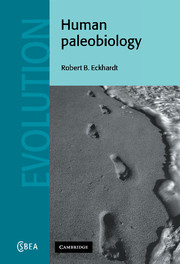Book contents
- Frontmatter
- Contents
- Preface
- Acknowledgments
- 1 Paleobiology: present perspectives on the past
- 2 Constancy and change: taxonomic uncertainty in a probabilistic world
- 3 A century of fossils
- 4 About a century of theory
- 5 Human adaptability present and past
- 6 Primate patterns of diversity and adaptation
- 7 Hominid phylogeny: morphological and molecular measures of diversity
- 8 Plio-Pleistocene hominids: the paleobiology of fragmented populations
- 9 Character state velocity in the emergence of more advanced hominids
- 10 The paleobiology of widely dispersed hominids
- 11 Paleobiological perspectives on modern human origins
- 12 A future for the past
- Bibliography
- Index
10 - The paleobiology of widely dispersed hominids
Published online by Cambridge University Press: 18 December 2009
- Frontmatter
- Contents
- Preface
- Acknowledgments
- 1 Paleobiology: present perspectives on the past
- 2 Constancy and change: taxonomic uncertainty in a probabilistic world
- 3 A century of fossils
- 4 About a century of theory
- 5 Human adaptability present and past
- 6 Primate patterns of diversity and adaptation
- 7 Hominid phylogeny: morphological and molecular measures of diversity
- 8 Plio-Pleistocene hominids: the paleobiology of fragmented populations
- 9 Character state velocity in the emergence of more advanced hominids
- 10 The paleobiology of widely dispersed hominids
- 11 Paleobiological perspectives on modern human origins
- 12 A future for the past
- Bibliography
- Index
Summary
Introduction
Prior to the profound environmental changes that led to the evolution of semi-terrestrial and terrestrial papionines and hominids, vast tropical forests and woodlands in Eurasia and Africa had been occupied by ancestral monkey and ape populations (Andrews, 1992). Many of these disappeared with the increased aridity that caused the near-obliteration of the Mediterranean Sea. Thus when later hominids expanded numerically and geographically, they reoccupied a Eurasian territory that had become radically different – i.e. one that was more arid over broad areas and ecologically much patchier.
The evidence indicates that evolving hominids met these new challenges by adaptive strategies in which material culture and more flexible behavior patterns played relatively greater roles than had ever been the case among primates, including ancestral hominoids and the earlier African hominids descended from them. These new patterns exceeded those of papionines that, using their own complex of adaptive strategies, also had expanded across much the same area of Eurasia and Africa over a broadly comparable time period. It has been suggested that the advent of greater use of material culture in more advanced hominids may be attributed to the capacity for observational learning made possible by enhanced cognitive abilities (Beck, 1974).
Until hominids accomplished their major range expansion beyond Africa, much variation would have reflected evolutionarily-accrued adaptations to the variety of habitats available on that continent – e.g., desert, open savanna, woodland savanna, tropical forest – superimposed, of course, on characters of heritage.
- Type
- Chapter
- Information
- Human Paleobiology , pp. 235 - 256Publisher: Cambridge University PressPrint publication year: 2000



